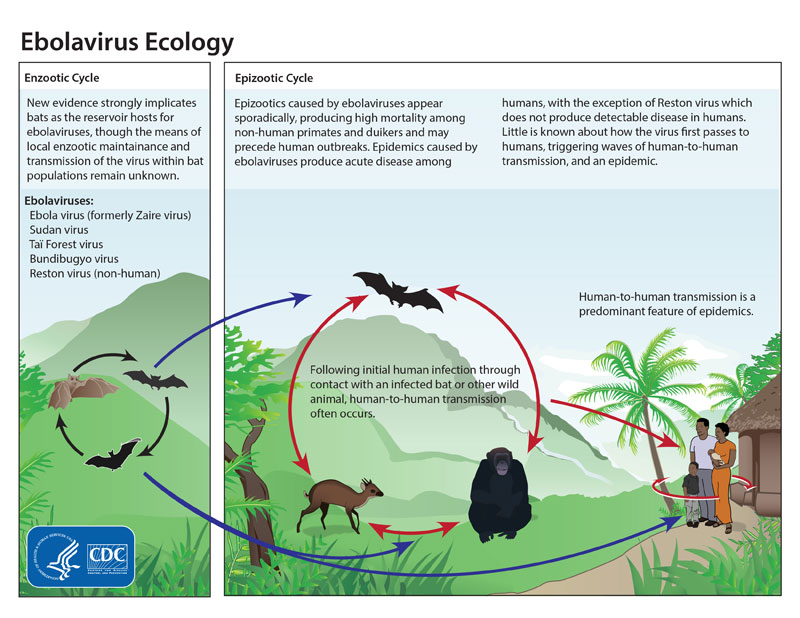1. What causes Ebola virus disease?
Ebola virus is a RNA virus belonging to family Filoviridae. The 5 species of Ebola virus are: Bundibugyo ebolavirus (BDBV), Zaire ebolavirus (EBOV), Reston ebolavirus (RESTV), Sudan ebolavirus (SUDV), Taï Forest ebolavirus (TAFV). Zaire ebolavirus (EBOV) is the most dangerous amongst these. Reston ebolavirus has caused disease in non-human primates but no disease by the strain has been recorded in humans till date.
2. How is Ebola transmitted?
Evidences till now suggest Ebola virus to be a zoonotic disease and humans are not the natural hosts. Infected fruit bats are thought to transmit the disease to humans, or indirectly through other animals like Gorilla, Chimpanzee, Antelopes, Porcupine, etc. which are hunted for their meat. Bat drops partially eaten fruits and pulp, which may later be eaten by these land mammals. The possible routes of infection and human to human transmission are:
- Close contact with the blood, secretions, semen, organs or other bodily fluids of infected or dead animals or humans
- Consumption of infected bushmeat
- Touching objects that have come in contact with the virus
Although, you wouldn’t want to get any fluids on you, but the virus is thought to be transmitted only through the mucous membranes (mouth, nose, vagina, rectum, etc.) and non-intact skin (wounds, cracks, etc). Sexual mode of transmission is possible.
3. Does Ebola get transmitted through air, food or water?
No. According to CDC, you can’t get Ebola thorugh air, water or food. However, researches suggest aerosal transmission in non-human primates and possibility of mutation in near-future to be able to do so in humans.
4. Who are at high risk of contracting Ebola infection?
During, an outbreak the highest risk of infection is among the health care workers involved in treatment of the patients. Also, the family and friends of the infected person are high risk groups.
5. Does Ebola get transmitted from infected person who is asymptomatic?
No. Asymptomatic individuals are not contagious. The incubation period of the disease ranges from 2 to 21 days. This means, it may take from 2 to 21 days for an infected person to develop symptoms after the exposure. During, this period the person remains non-contagious.
 6. What are the symptoms of Ebola virus disease?
6. What are the symptoms of Ebola virus disease?
Initially: Fever, Sore throat, Severe headache, Muscle pain, Intense weakness
Later: Vomiting, Diarrhea, Rash, Impaired kidney and renal function, Internal and External bleeding
The most common cause of death is due to multiple organ failure rather than bleeding which is not a common manifestation as portrayed in movies.
7. Is there a vaccine or cure for Ebola?
No. Prevention is the best option. Treatment is based on the line of supportive therapy like maintenance of fluid, oxygen, blood pressure, etc. New drug therapies are under evaluation.
8. How fatal is Ebola virus disease?
The fatality rate is from 50-90% based on the availability of advanced life support facilities in the region. Still, this means a high risk of mortality. The current outbreak, in which at least 1,711 people have so far been infected, of whom 932 have died, is the most severe in the almost 40 years since Ebola was identified in humans.
9. How can Ebola be prevented?
- Do not touch sick people who show symptoms of Ebola including for example fever, diarrhea, vomiting, headaches and sometimes heavy bleeding.
- Do not touch the dead bodies of suspected or confirmed Ebola patients.
- Wash your hands with water and soap regularly.
- Gloves and appropriate personal protective equipment should be worn when taking care of ill patients at home.
- Awareness is needed among the people of affected communities about the nature of disease, outbreak containment and safer measures for cremation of the infected dead body.
10. Why is Nepal in high risk for spread of Ebola? What preventive measures should be undertaken?
Significant number of Nepalese including Peace-keeping forces work in the regions of outbreak like Nigeria and Liberia.
Our neighboring country, India has opted a strategy to prevent entry of disease from the high-risk nations. Travelers to India from affected areas are required to self-report during immigration. In-flight announcements informing passengers to report symptoms have been installed. Facilities at airports to manage travelers showing symptoms have been put in place. In the event that any of these travelers develop symptoms, a surveillance system has been set up to track them.
We are still lagging behind in implementing such control strategies at airports. However, if a case is detected, he/she must be isolated for atleast a month and treated. Till date among the recorded cases, the virus was detected in semen of an infected person upto 61 days.
Sources of Information:
WHO (World Health Organization)
CDC (Center of Disease Control, USA)
Times of India




When will scientists discover the medicines .how much of time they will take
ZMapp is an experimental treatment – a combination of three different monoclonal antibodies that bind to the protein of the Ebola virus. Two American aid workers who fell sick with Ebola in Liberia saw their conditions improve by varying degrees after they received ZMapp.